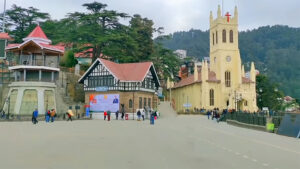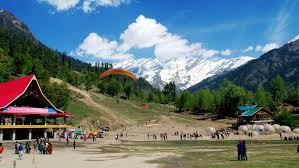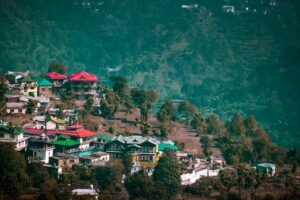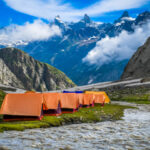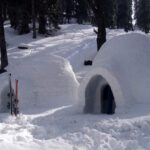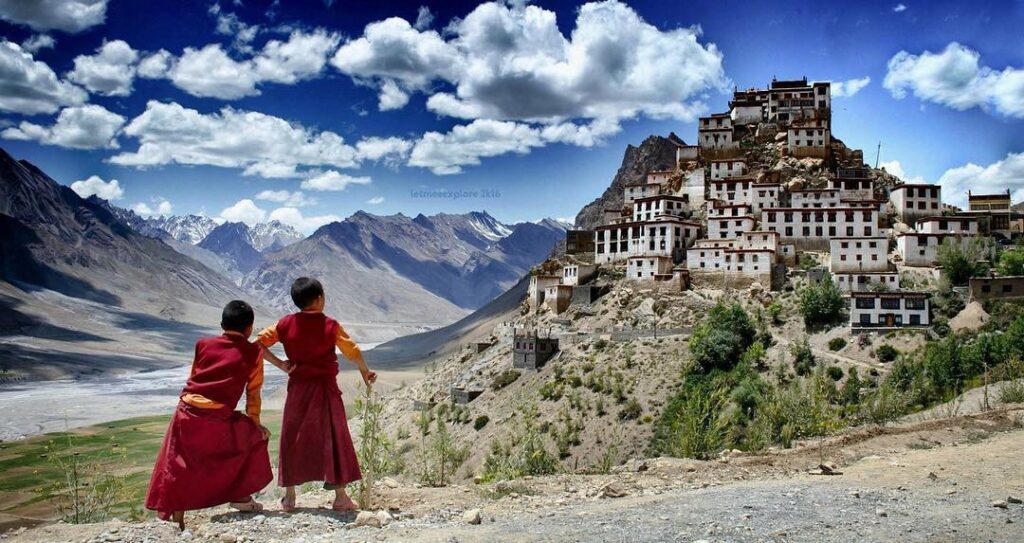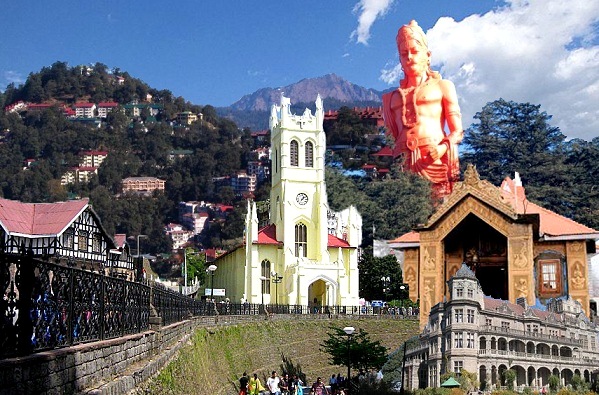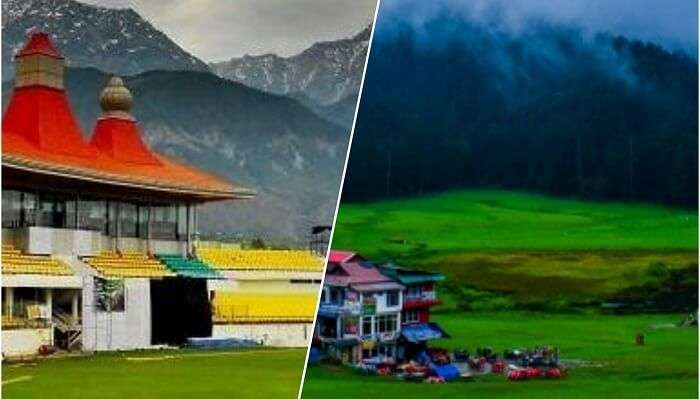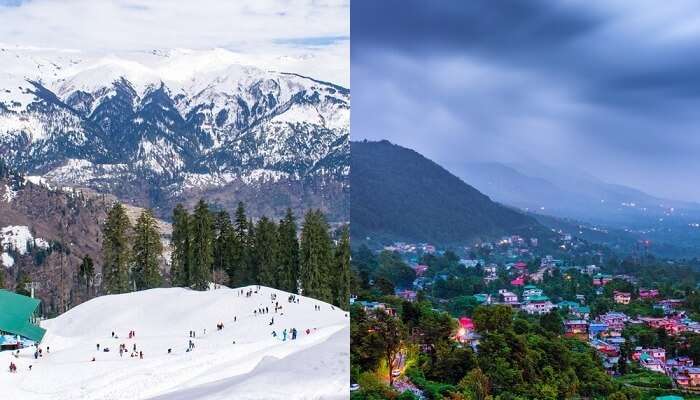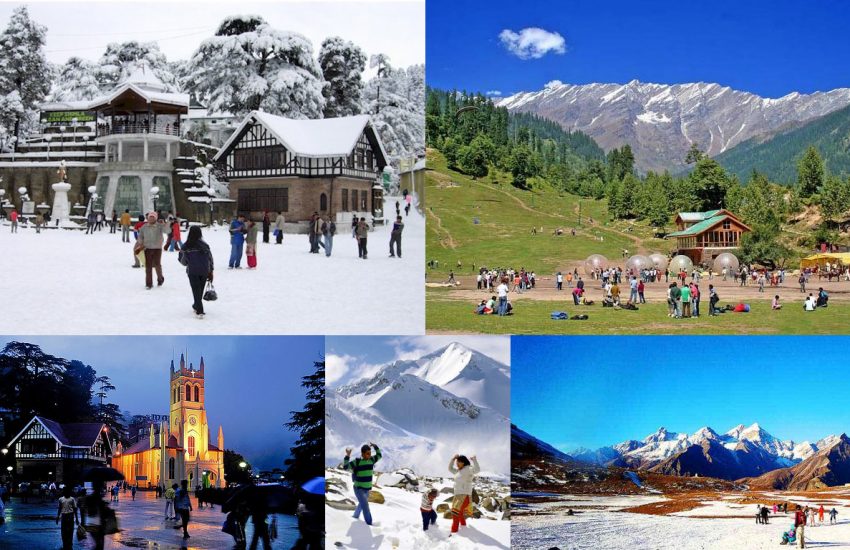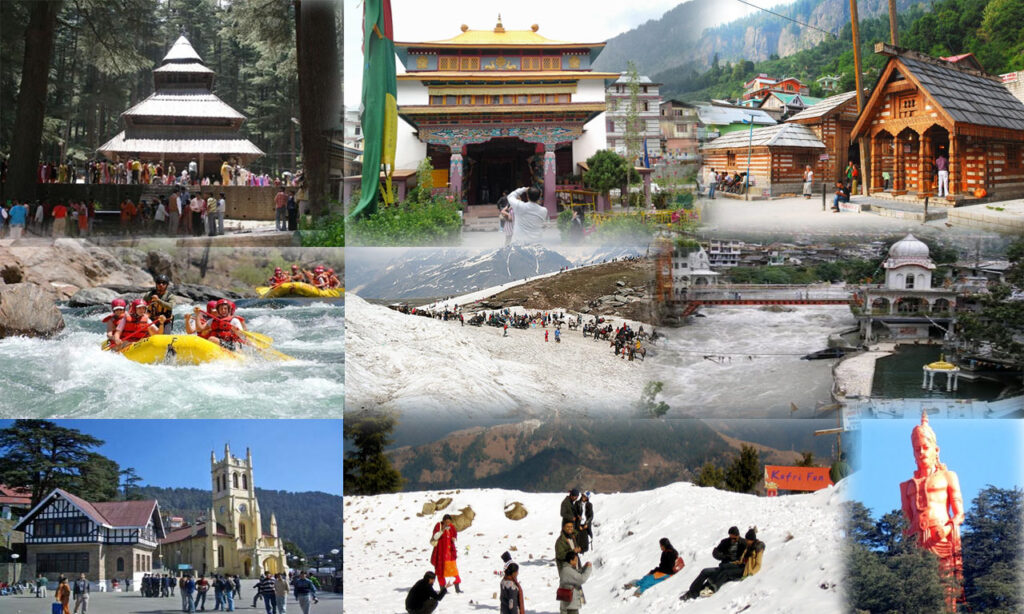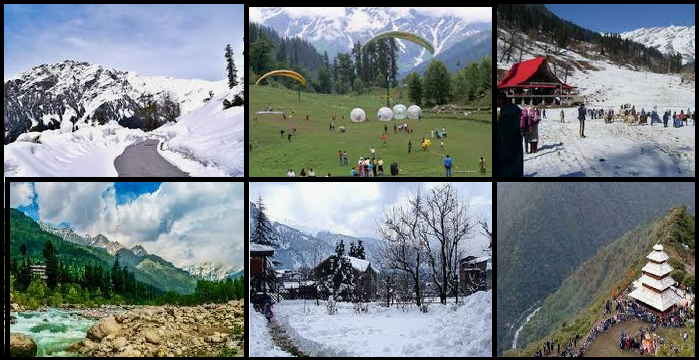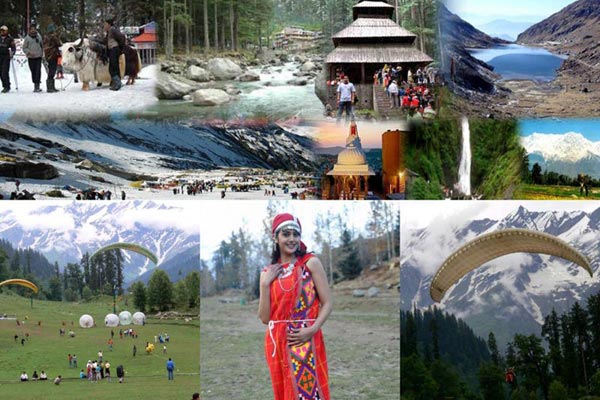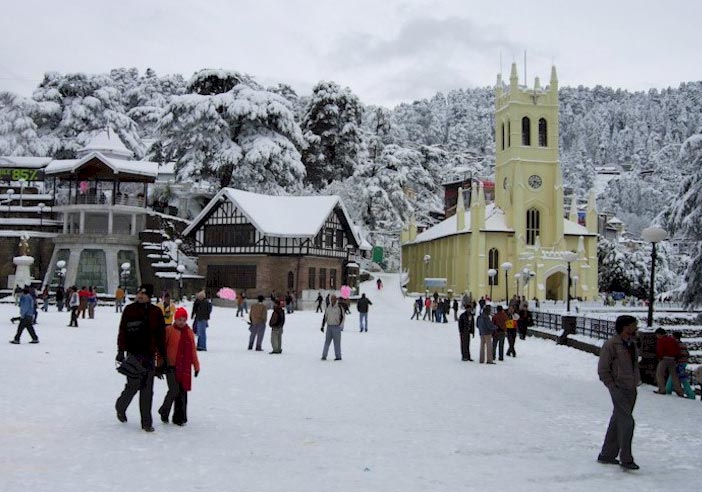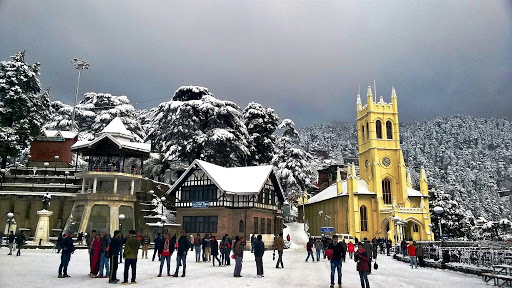07 Day(s) 06 Night(s)

Himachal Pradesh
Himachal Pradesh is a state situated in the northern part of India at the foothills of the western Himalayas. It is bordered by the Indian union territories of Jammu and Kashmir to the North, and the states of Punjab to the West, Haryana to the Southwest, Uttar Pradesh to the South and Uttrakhand to the Southeast, and Tibet-China to the East. Shimla is the state capital, while Dharamshala is the second capital in the winter of Himachal Pradesh. It is divided into three Divisions – Mandi Division, Kangra Division and Shimla Division. The divisions are further sub-divided into 12 Districts. It is referred as “Dev Bhoomi” translating to “Abode of Gods” due to large number of Hindu temples of Hindu deities, Monasteries and other religious places. Hindi is the most widely spoken languages and is also the official language of the state. Beside Hindi, people speaking Western Pahari or Punjabi.
After independence, Himachal came into existence on 15th April, 1948 as a province governed by the Chief Commissioner. It became a part ‘C’ state on 26th January, 1950 and became Union Territory on 1st November, 1956. After reorganization of Punjab, its hilly areas like Kangra, Una districts and other hill areas were merged with Himachal Pradesh on 1st November, 1966. On 18th December, 1970, the parliament passed the state of Himachal Pradesh Act and on 25th January, 1971, Himachal became 18th State of Indian Union with Dr. Yashwant Singh Parmar as first chief minister.
Himachal Pradesh is known as the “Fruit Bowl of the country” and produces a wide range of fruits including apple, peach, plum, apricot, and more.
Snow Leopard is the state animal, Western Tragopan is the state bird and Pink Rhododendron is the state flower of Himachal Pradesh. The state has 33 Wildlife Sanctuaries and 2 National Parks, namely – Great Himalayan National Park, a UNESCO world Heritage site and Pin Valley National Park.
The culture of Himachal Pradesh is rich in traditions and diversity, and it is not yet affected by the western glitters, largely due to lofty terrains and challenging reach. The costumes of Himachal people are very beautiful and it is made according to the weather conditions. The traditional dress for Men is tight Churidar Pyjamas with kurta and long silk overcoat. The traditional dress for Women is Salwar- Kameez, Ghagharis and Cholis. Himachali Caps of various colour bands are well known local art work, and are treated as a symbol of the state identity. It is also famous for its handicrafts, especially Kullu Shawls, Chamba handkerchiefs and footwear (chappal), caps.
Local music and dance also reflects the cultural identity of Himachal. The state’s most famous traditional dance forms are the Kullu Naati, Gugga Dance, Ghurehi and Losar Shona Chuksam that performed at local festivals and special occasions. Apart from national festivals, there are many regional festivals and fairs celebrated by local. Some of these festivals are Kullu Dussehra, Lavi fairs, Mandi Shivratri, Chamba Minjar fair, Baisakhi and Renuka fair. The traditional foods in Himachal are Madhra, Babru, Siddu, Chha Gosht, Akotri, Chutney of til and many more.
Himachal Pradesh is home to lofty snow-peaked mountains, glaciers, Lush green Valleys, lakes, rivers, ancient hindu temples and monasteries that attracts tourists all over the world. Shimla, Kasauli, Manali, Dharamshala, Mcleodganj, Palampur, Dalhousie and Khajjiar are some of famous destinations in Himachal Pradesh for domestic and foreign tourists. It is also hub of adventure tourism activities such as ice-skating, river rafting, paragliding, trekking and the likes. In 2015, it hosted the first Paragliding World Cup at Bir-Billing in India.
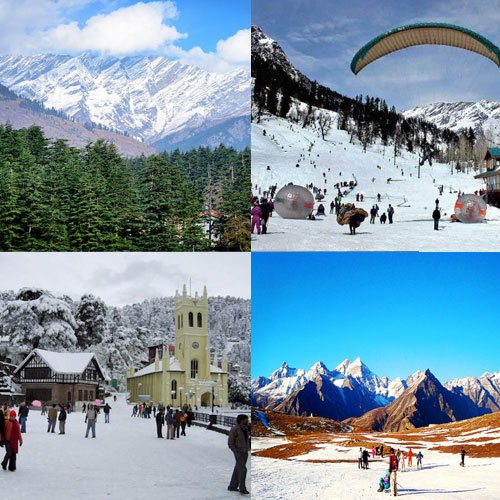

Places To visit
Things To Do
How To Reach
Local Transportation
Places To visit
Himachal Pradesh is a large mountainous region with lofty snow covered peaks, lush green valleys, temples, monasteries, UNESCO Heritage Sites, several lakes and rivers, unblemished nature, culture, and abundant adventurous sports, which made Himachal perfect destination for nature lovers, adventurers, backpackers and honeymooners.
1. Shimla – The hill Station with rich colonial history
Shimla is one of popular and mesmerizing hill stations of the Northern India state, Himachal Pradesh, filled with snow covered mountains, lush greenery, enchanting lakes and ripping rivers. It is situated at the foothills of Himalayas, an altitude of 2206 metres (7238 ft) above sea level. It also known as “Queen of the Hills”. The name of Shimla derived from “Goddess Shyamala”, an incarnation of Goddess Kali.
Shimla was summer capital of the British Government during they ruled India. Now, it is the capital city of Himachal Pradesh. It has retained the aura of that time with British architecture and historic railway. Apart from these, it offers adventure sports such as ice-skating, trekking, skiing, forest camping and rock climbing. There are number of places located near Shimla which are equally fascinating to visit. Some of those places are Kufri, Chail, Kasauli, and Tirthan Valley.
One can reach Shimla through Chandigarh-Shimla highway or train upto Kalka and then either catch the toy train (Kalka-Shimla) or hire a taxi, or take bus, to Shimla. It is located around 15 km from Kufri, around 46 km from Chail, around 71 km from Kasauli, around 112 Km from Chandigarh, around 226 km from Dharamshala, around 227 km from Dehradun, around 237 km from Manali, around 315 Km from Amritsar, around 317 Km from Dalhousie and around 342 Km from Delhi. The Major attractions of Shimla are:-
|
|
|
|
|
|
|
|
|
|

2. Kullu – The Valley of God
Kullu is capital town of Kullu district in the Himachal Pradesh. It is situated on the bank of Beas River in the Kullu Valley, at altitude of 1278 m (4193 ft) between Pir Pranjal, Lower Himalayan and Great Himalayan Ranges. It was earlier known as Kulant Peeth which means “end of habitable world”. It is also known as the” Valley of God”. Kullu Valley is known for its temples (including gurudwara), beauty and its majestic hills covered with Deodar and Pine trees and sprawling Apple orchards. It offers numerous adventure sports and activities such as river rafting, paragliding, trekking, mountaineering, angling and hiking. Kullu often heard with the name Manali which is another famous tourist destination. Kullu Dussehra is famous festival of the town which is take place in the month of October or November for seven days.
It is located around 40 km from Manali, around 180 km from Dharmshala, around 200 km from Shimla, around 258 Km from Chandigarh, around 356 Km from Amritsar and around 500 Km from Delhi. The Major attractions of Kullu are:-
|
|
|
|
|
|
|
|
|
|
3. Manali – India’s Honeymoon and Adventure Capital
Manali is one of the most beautiful hill stations of Himachal Pradesh, filled with snow-clad mountains, gorgeous valleys, gushing river, pine and deodar forests. It is situated in the Kullu district near the Northern end of the Kullu Valley at altitude of 2050 m (6730 ft). It serves as the gateway to Lahaul and Spiti as well as Leh. The place is named after the Hindu lawgiver Manu. The word Manali is derived from “Manu -Alaya” which mean “the abode of Manu”.
Manali offers a blend of tranquility and adventure that make it haven for adventure enthusiasts, honeymooner and couples. It also has the antique temples and Tibetan monasteries, hippie villages and trekking trail. Apart from these, There are lot of adventure sports and activities such as paragliding, trekking, skiing, snow scooter, zorbing and mountain biking. Therefore, It is called the adventure capital of the state. Dussehra and Hadimba Devi festival are the major festivals that are celebrated with great passion.
Manali is accessible through road from Delhi and Chandigarh or can opt for the flight upto Bhuntar then take either a local taxi or bus. It is located around 40 km from Kullu, around 225 km from Dharmshala, around 237 km from Shimla, around 301 km from Chandigarh, around 400 km from Amritsar and around 545 km from Delhi. The Major attractions of Manali are:-
|
|
|
|
|
|
|
|
|
|
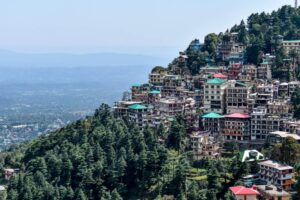
4. Dharamshala & Mcleodganj – Little Lhasa in India
Dharamshala, the winter capital of Himachal Pradesh is the most famous hill station, surrounded by snow clad Dhauladhar Mountains, amazing valleys and thick cedar and pine trees. It is situated in the Kangra District near Kanga Valley.
Dharamshala is divided into two parts with different altitudes, one is lower Dharmshala, at altitude of 1457 m (4780 ft) from sea level, which contains the commercial centers, educational institutions and hospitals, and other is upper Dharamshala, at altitude of 2082 m (6831 ft) from sea level, which is known more commonly as Mcleodganj (also known as Little Lhasa) where is inhabitated largely by the Tibetan community. Mcleodganj is home to the world famous Tibetan spiritual leader – The Dalai Lama who came to India from Lhasa with his followers and choosed Mcleodganj as abode, transforming it into “little Lhasa”. It is perfect amalgamation of natural beauty and Buddhist culture. These places are some fascinating monasteries, ancient temples, churches and museums.
Apart from these, there are many activities to do such as trekking, camping, Tibetan Language courses, Tibetan cooking courses, and yoga & meditation. Mcleodganj is also a major shopping center for Tibetan handicrafts, carpets, wooden masks, etc.
Dharamshala is accessible through flight upto Gaggal then take either a local taxi or bus, or can opt train upto Pathankot then drive to Dharamshala. The roads are also well connected to Dharamshala. It is located around 85 km from Pathankot, around 118 km from Dalhousie, around 193 km from Jammu, around 215 km from Amritsar, around 225 km from Manali, around 226 km from Shimla, around 236 km from Chandigarh and around 484 km from Delhi. The Major attractions of Dharamshala are:-
Kalchakra Temple, the Namgyal Gompa monastery, and the Tibetan Museum. |
|
|
|
|
|
|
|
|
|
5. Dalhousie – Mesmerizing Charm with Colonial Architecture
Dalhousie is one of most renowned scenic hill station in Chamba district of Himachal Pradesh, surrounded by snow-capped mountains, lush pine and oak trees and flower-bedecked meadows. It is also blessed with cascading waterfalls, lakes, gushing river and magnificent misty mountains. It is spread out over 5 hills of Kathlog, Terah, Potreyn, Bakrota and Bhangora, at altitude of 1970 m (6460 ft) above sea level.
Dalhousie was named after Lord Dalhousie, a former British Governor-General in India, who established this place in 1950 as summer retreat. As a result, the town has Scottish and Victorian architecture is prevalent in the various buildings. It also offers many activities for adventurers and nature lovers. Some of those activities are trekking, camping, river rafting, Paragliding, boating, canoeing and kayaking.
Dalhousie is accessible through flight upto Gaggal then take either a local taxi or bus, or can opt train upto Pathankot then drive to Dalhousie. The roads are also well connected to Dalhousie. It is located around 22 km from Khajjiar, around 53 km from Chamba, around 81 km from Pathankot, around 118 km from Dharamshala, around 175 km from Jammu, around 196 km from Amritsar, around 370 km from Manali, around 317 km from Shimla, around 312 km from Chandigarh and around 578 km from Delhi. The Major attractions of Dalhousie are:-
|
|
|
|
|
|
|
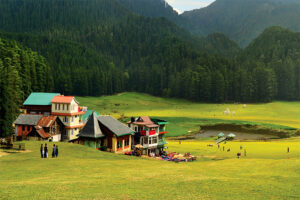
6. Khajjiar – Mini Switzerland in India
Khajjiar is tiny plateau with a small stream-fed lake in the middle, surrounded by dense deodar and pine forests, and lush green meadows. It is located about 22 km from Dalhousie at altitude of 2000 m (6500 ft) above sea level in the foothills of Dhauladhar ranges of the western Himalayas. It is one of the 160 locations in the world to have been designated “Mini Switzerland”. This small paradise boasts of forests, lakes and grasslands which are a rare and unique combination. This place also attracts adventure seekers and has numerous adventurous activities to experience such as zorbing, trekking, paragliding and horse riding. This beautiful region is must visit place for everyone coming to Dalhousie.
It is located around 23 km from Chamba, around 96 km from Pathankot, around 120 km from Dharamshala, around 195 km from Jammu, around 210 km from Amritsar, around 336 km from Shimla, around 381 km from Manali, around 326 km from Chandigarh and around 592 km from Delhi. The Major attractions of Khajjiar are:-
|
|
|
|
7. Kasauli
Kasauli is small hill-town in the southwestern part of Himachal Pradesh in the Solan district at altitude of approximately 1800 m (5906 ft) above sea level. It also serves as cantonment which was established by the British Government in 1842.
The name of Kasauli came from “Kausalaya”, a mountain stream which flows between Jabli and Kasauli. According to the mythological tales, Kasauli have been the resting place of lord Hanuman while he was searching for the “Sanjeevani Booti” in the Himalayas.
This hill-town is well known for its snow covered mountains, pines and cedar forests, and herbs, that surround the region. It also famous for sumptuous Victorian-style buildings built by the Britishers who resided here years back. It also offers adventure activities such as camping, trekking and paragliding.
Kasauli is placed halfway between Shimla and Kalka. It is located around 25 km from Solan, around 58 km from Chandigarh, around 72 km from Shimla, around 184 km from Dehradun, around 267 Km from Amritsar and around 306 Km from Delhi. The Major attractions of Kasauli are:-
|
|
|
|
|
|
|
|
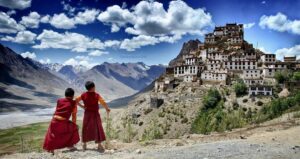
8. Spiti Valley – An adventure lover’s paradise and known as Little Tibet
Spiti is majestic cold desert valley in the North eastern part of Himachal Pradesh, filled with snow- capped mountains, green meadows, gushing river, lakes and exquisite villages. The Valley is located high in the Himalayas at an altitude of 3800 m (12500 ft) above sea level. The name Spiti means “The Middle Land”, i.e. the land between India and Tibet. The sub-divisional headquarters (capital) of Spiti is Kaza which is located along the Spiti River. It gets only around 250 days of sunshine in the year, making it to be one of the coldest places in the country. Due to heavy snowfall and thick ice conditions, Spiti valley is cut off from the rest of the country for around 6 Months of the year. It is accessible only during the summer months via motorway.
A picturesque paradise, Spiti Valley is home to several beautiful Buddhist monasteries, and will witness of a large number monk (who wear the maroon robes) praying with their prayer wheels, fluttering prayer flags in the air. It also offer many adventurous activities like trekking, mountain biking, camping under the stars, yak rides, river rafting, rappelling and wildlife spotting.Tourists often spot the Bharal (also called the Blue Sheep), Himalayan Ibex, Red fox and lucky one may also spot a Snow Leopard too.
Because of its remote site, Spiti Valley has no access to air or train network. The only way to reach Spiti Valley is through road which is connected to both Manali and Shimla. It is located around 177 km from Manali, around 217 km from Kullu, around 423 km from Shimla, around 475 km from Chandigarh, around 572 km from Amritsar, around 623 km from Ladakh and around 723 km from Delhi. The Major attractions of Spiti Valley are:-
|
|
|
|
|
|
|
|
|
|
|
|
Things To Do
The destination has an enormous range of things that tourists can experience and explore on tour to Himachal Pradesh.
-
- Adventure Activities:-
|
Camping |

Paragliding |
 Skiing Skiing |
 Mountain Biking Mountain Biking |

Trekking |
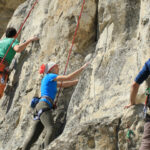 Rock Climbing Rock Climbing |
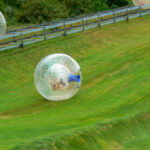 Zorbing Zorbing |
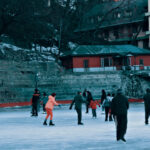 Ice Skating Ice Skating |

Snow Scooter |
 Snow Boarding Snow Boarding |
-
- Indulge in Water Sports/Activities:-
|
River Rafting |
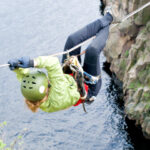
River Crossing |
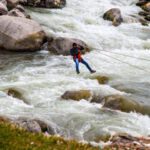 Ziplining Ziplining |
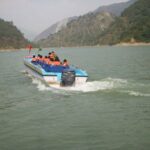 Boating Boating |
-
- Cultural and Religious Experience:-
|
Himachali Cuisine |
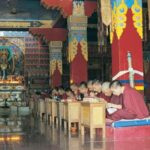
Explore Tibetan Culture |
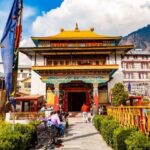 Visit Pilgrimage sites Visit Pilgrimage sites |
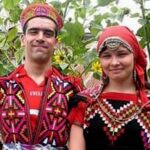 Wear Himachali dress Wear Himachali dress |
-
- Leisure Activities:-
|
Stay in Igloo |
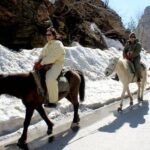
Horse Riding |
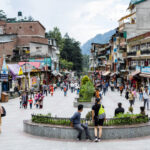 Stroll at Mall Road Stroll at Mall Road |
 Dance party at restro bars and café
Dance party at restro bars and café |
 Shopping Shopping |
 Fishing Fishing |
-
- Live in a Heritage Hotel in Shimla
-
- Visit Asia’s Oldest Brewery in Kasauli
-
- Enjoy Wildlife Safari
How To Reach
Himachal Pradesh is nestled in the lap of the Western Himalayas, and it is a destination with mesmerizing beauty and adventure activities, that draws attention of people from various parts of India and globe. It is well connected to the rest of the country through airway, railway and roadway, which make it feasible for the travelers to travel to /from Himachal Pradesh.
By Air
Himachal Pradesh has three Domestic airports –
- Bhuntar Airport in Kullu District, around 10 km from Kullu, and serves as the gateway to the northern parts of the state like Manali and Lahaul-Spiti.
- Gaggal Airport (also known as Kangra Airport and sometimes referred to as the Dharamshala Airport) in Kangra District, around 13 km from Dharamshala and 10 km from Kangra, and serves as gateway to the northwestern part of the state Like Dharamshala and Dalhousie.
- Jubbarhatti Airport in Shimla District, around 21 km from Shimla, and serves as the gateway to the Southern part of the state like Shimla, Solan, Bilaspur, Mandi and Kinnaur.
These airports are not well connected with many cities and towns of the country via direct flights. Travelers will need to arrive at Delhi or Chandigarh to find connecting flights to other major cities in India. During winter, flights could be cancelled at the last minute because of harsh weather conditions. The nearest international airport from Himachal is situated in Chandigarh (Chandigarh International Airport) and Delhi (Indira Gandhi International Airport). Upon arrival, travelers can avail taxi, car rental or bus as per their convenient to reach their required destination.
By Train
Himachal Pradesh has limited railway network due to difficult lofty hills terrain. It has two narrow – gauge railway lines-
- Kalka-Shimla Railway Line – To reach Shimla is by Kalka-Shimla Toy Train that is also a UNESCO World Heritage site connects Kalka (in Haryana) to Shimla. Its length is around 95 km, and it passes through 102 tunnels, crosses 864 bridges and 900 curves. This railway is known to be an engineering marvel of the British era.
- Kangra Valley Railway Line which connects Pathankot (in Punjab) to Joginder Nagar and its length is approximately 160 Km. It passes through a maze of hills and valleys.
There are only broad-gauge line exists which connects Una Railway Station to Nagal Dam (in Punjab) and runs all the way to Daulatpur, Himachal Pradesh. Una is connected to Delhi by Himachal Express and Jan Shatabdi Express. There are some proposals for new lines in the Himachal to increase commercial use. Upon arrival, travelers can avail taxis, buses and car rental for transfers from railways to desired destination.
By Road
Road is the best and the most efficient way of travelling to Himachal Pradesh. The state has a good road network, in which 9 are national highways and 19 state highways that connects it to rest of the country. There are around 45 major district roads that allow traveling to remotest area of the state. Some roads can also be closed during winter or monsoon due to excessive snowfall or landslides. There are numerous privately-operated buses and state Government-run buses (i.e. Himachal Road Transport Corporation), from local to Luxury, that ply at frequent or regular intervals from neighboring state of Delhi, Haryana, Punjab, Uttrakhand, Kashmir and Uttar Pradesh to Himachal. Travellers from nearby destinations can opt to drive their own vehicle to Himachal Pradesh and also hire private cars or taxies.
Local Transportation
Himachal Pradesh has numerous mode of transport to travel within the state that travellers can choose as per their Budget, Preference and convenience.
Buses
Buses are quite inexpensive and convenient, and travelers get to see the fascinating scenic beauty and small hamlets and towns while travelling which they might have missed otherwise. Himachal Pradesh has an excellent bus service system in and around the state, operated by Government-Run Himachal Road Transport Corporation (HRTC) and Himachal Pradesh Tourism Development Corporation (HPTDC). Apart from that, private operators also cater to the need of tourists. Buses are easily available in every city, town, and village, and reach the most remote corners of the state. Most of buses ply at regular intervals between Delhi and Shimla, Kullu, Manali and Dharamshala. Himachal Pradesh Tourism Development Corporation also offers buses for local sightseeing tours.
Trains
Himachal Pradesh has limited railway network due to difficult lofty hills terrain. However, trains are not used to travel within the State. The State has two narrow – gauge railway lines, namely – Kalka-Shimla Railway Line and Kangra Valley Railway Line. There are only broad-gauge line exists which connects Una Railway Station to Nagal Dam (in Punjab) and runs all the way to Daulatpur, Himachal Pradesh. There are some proposals for new lines in the Himachal to increase commercial use.
Auto Rickshaws
Auto Rickshaws, also called an auto, are available all over Himachal, but they have their specific region in which they operate and do not go beyond their region. Travellers can find auto stands at almost every Bus Stand, Railway Stations, and at important places.
Taxis/Cabs
Taxis are one of the most popular modes of transport in Himachal Pradesh, and are comfortable, convenient and safer than auto rickshaws. This is preferred by travellers when they are alone or going to an unknown destination even though the rates will be higher than auto. They are easily available at the Bus stand, the railway stations, outside most popular hotels and other important places, for travelling to desired destination. Moreover, most hotels /resorts also arrange a taxi for tourist on request. However, private vehicles are not allowed in some of the tourist places such as Rohtang pass, the Ridge, etc.
Foot
Every place of interest is not possible to cover on foot but a small locality can be explored in detail. Trekking tours to beautiful valleys interspersed with streams and waterfalls are also available.
Rental
Travellers have also an option of renting cars/ motorcycles for exploring Himachal Pradesh at their own pace. A number of companies provide both self-driven and chauffeured cars for rental. Travellers should check out the credibility and past records of the rental companies before hiring vehicles. Rates vary according to the vehicle, the model, the season and how long one wants to rent it. Rules and prices of renting can also vary from company to company. Rental companies can also charge a security deposit and ask for submitting a copy of the driving license (National or International) and some original ID such as passport, pan card or voter ID which is given back once the vehicle is returned.
TOUR PACKAGES OF HIMACHAL PRADESH
Inclusions & Exclusion
Important Information
FAQ
Inclusions & Exclusion
Inclusions:-
- Assistance on Arrival.
- Accommodation on double sharing basis with breakfast in Shimla, Kasauli, Manali, Kasol, Dharamshala, Dalhousie and Chandigarh.
- Accommodation on double sharing basis with breakfast & dinner in Kaza, Tabo and Lallung.
- Camp accommodation on double or Triple sharing basis with breakfast & dinner in Chandratal.
- The vehicle is available strictly as per the itinerary and not at disposal. (Note: A/c will not run in Hilly Area.)
- Semi – Sleeper A/c Volvo Bus tickets (for Roundtrip) are included in Shimla Tour by Volvo , Enchanting Kullu Manali Tour by Volvo, Exotic Manali Shimla Tour by Volvo and Spiti with Manali Tour.
- All entry permits, entry tickets included to all sight-seeing points.
- Entrance fee for monuments as listed in the itinerary.
- All parking fee, Road taxes, Fuel and toll charges etc.
- Child below 5 yrs sharing same bed with parents will be complimentarily.
- For Honeymooners:
- One flower decoration, special honeymoon cake, candle light dinner on the day of arrival in Himachal Pradesh.
- Fruit Basket in the Room.
- Every Night Two glass of Badam Milk.
- Non a/c fresh up room for an hour, if required, in case of arrival is before 7 AM.
Exclusions:-
- Air or Train fare.
- Adventure activities like skiing, paragliding, Rafting, etc in Himachal Pradesh.
- Additional Charges of Rohtang pass to be paid directly to the transporter as per rule of Manali taxi union.
- Additional excursions or sightseeing or extra usage of vehicle, other than mentioned in the itinerary.
- Any expenses caused by reasons beyond our control including but not limited to bad weather, natural calamities (landslides, floods), flight delays, excess baggage, rescheduling or cancellations, any accidents, medical evacuations, riots, strikes, war, airline or hotel policies etc.
- Any increase in taxes or fuel price, leading to increase in cost on surface transportation & land arrangements, which may come into effect prior to departure.
- Meals other than specified in the inclusion.
- Tour guide services at any sightseeing place.
- Camera Tickets are NOT INCLUDED in the mentioned cost of Sightseeing & Transfers.
- Any portage at airports and hotels, tips, Visa, insurance, Alcoholic and non alcoholic beverages, mineral water, telephone charges and all items of personal nature.
- Compulsory Gala Dinner on X’mas & New year Eve if applicable.
- Any services not specifically mentioned in the inclusions.
- Card surcharge if payment through credit card
- Peak season supplements and charges.
- All applicable government taxes.
- Optional activities mentioned in the itinerary & anything not mentioned in the above package.
Note: Inclusion And Exclusion Of Customized Trips Will Be Provided On Request.
Important Information
- The following tourist attractions remains closed on Monday:-
In Shimla-
- The Himachal State Museum (also known as Shimla State Museum).
- Annandale Army Heritage Museum, Timings: 10:00 am to 2:00 pm and 3:00 pm to 5:00 pm.
In Dharamshala-
- TsuglagKhang Complex, Timings: 5 am to 8 pm from April to October; 6 am to 6 pm from November to March.
In Naggar-
- Roerich Art Gallery
- The following tourist attractions remains closed on Tuesday:-
In Manali-
- Rohtang Pass, also from November to April due to heavy snowfall
- The following tourist attractions remains closed on Sunday:-
In Manali-
- The Manali Gompa
- Timings of Van Vihar, Manali-
- In the summer: 8:00 am to 7:00 pm
- In the winter: 8:00 am to 5:00 pm
- To avoid last time disappointment booking tickets, accommodation and activities well in advance. Especially during peak season when most flights run full and price of flights, accommodation and activities got high. It is also necessary to re-confirm flight timings at least 24 hours before departure. If tourists are travelling in winter, flights and trains could be cancelled at the last minute due to difficult weather conditions.
- The list of essential things and must carry items while travelling to Himachal Pradesh are –
- Warm clothes including socks (Pack warm clothes depending on destination and the month of travel)
- Woolen Hand Gloves
- Comfortable shoes / Trekking Shoes (if planned for trekking)
- Hats or Caps
- Sunscreen Lotion & Moisturising Lotion
- First Aid Box including personal meditation
- Id Proofs
- Dark polarized sunglasses
- Camera with sufficient batteries and Memory Card
- Charger and Power banks
- Waterproof jackets and Umbrella for Monsoon trip
- Other necessities
- Things to carry during Hiking or Trekking are –
- Comfortable and Necessary clothes:
- Full sleeves T-shirt
- Track pants
- Fleece or down feather jacket
- Thermal
- Ponchos
- Windcheaters
- Waterproof Jacket and Pant
- Woolen and Sun cap
- Sunglasses
- Balaclava
- Trekking shoes (which have good grip and ankle support)
- Woolen and Cotton socks
- Woolen and Waterproof gloves
- Backpack with Rain cover (50-60 liter)
- Daypack with Rain cover (20-30 liter)
- Walking Stick / Trekking Pole
- Raincoat or Umbrella
- Torches, Emergency lights (with extra batteries)
- Water Bottle (Snow Trek requires more water bottle)
- Thermos
- First Aid Box including personal medication
- Light Snacks (that not need fire and water; Quick energy)
- Sunscreen Lotion & Moisturising Lotion
- Trek Route or Map
- Toiletries
- Camera with sufficient batteries and Memory Card
- Charger and Power banks
- ID proofs
- Dry bag for garbage
- Comfortable and Necessary clothes:
- Where to visit in Himachal Pradesh and when-
| Name of Places | Famous for | Things to do | Ideal For | Best time to visit |
| Kullu – Manali | Great Himalayan Ranges, Nature, Hill Station, Temples, Adventure Sports | Indulge in adventure sports at Solang Valley, Visit Manali Bird Sanctuary, Go trekking, camping, angling & river rafting in Kullu, Visit the Old temples | Everyone! But it is a hot favorite amongst newlyweds. | March to June(Summer) and November to January (Winter -for snowfal) |
| Shimla | Hill Station, Viewpoints, British colonial architecture | Full fill your shopping desire at the Mall Road, Enjoy a trek to jakhu hill and a visit to Lord Hanuman’s Temple, Visit to the Viceregal Lodge to appreciate the British elegance, Try your hands on Polo at Annandale which is 4km from the Ridge, Ice skating | Family and friends | March to June(Summer) and November to January (Winter -for snowfal) |
| Dharamshala | Tibetan Culture, Monasteries, Nature | Enjoy a boat ride across the Dal Lake and witness the royal the Kangra Fort, Temples & Monasteries visit, Enjoy the cascading Bhagsu falls, the Kangra Art Museum, Experience Tibetan cultural and see the magnificent tea plantation on the foothills of Kangra valley | Friends or Solo Travelers | March to June(Summer) and November to January (Winter -for snowfal) |
| Mcleodganj | Tibetan Culture, Monasteries, Nature | City sightseeing or tour around the city, Shop at the local markets for jewelry and woolens, Enjoy meals with mountain vistas | Family, friends, and solo travelrs | October to June |
| Dalhousie | Hill Sation ,Meadows, Valley | Experience the beauty of nature in the valley of Khajjiar which is also known as the Switzerland of India, Enjoy a gentle walk or a trek in the beautiful terrain in Dainkund Walk, Ganji Pahadi Walk and Bakrota Walk, Visit the St. John’s Church, oldest church of the town | Honeymooners | March and June |
| Khajjiar | Nature, temple | Visit the Khajjiar Lake and Ground via the Bakrota Hills from Dalhousie, Pay tribute to the Khajji Nag Temple which is one of the most ancient temples, Enjoy the serenity of local villages known for its apple orchards, Relish the mercerizing views of Mount Kailash which is believed to be the home to Lord Shiva | Family and friends | March and June |
| Kasauli | Hill Station, Viewpoints, British colonial period | Trekking, camping, bird watching, rappelling, nature walk, viewpoints, sightseeing | Family and friends | March to June & December to January for snowfall |
| Spiti Valley | Adventure activities, Nature, Monastery | Camping, wildlife sanctuary, white water rafting, biking, trekking, yak safari, village walk, Monastery visits, star gazing, fossil hunting | Family and friends | May to July |
| Kasol | Adventure activities, Nature, Village | Backpacking, camping, trekking, hiking, stargazing, bike riding, solo travel | Family and friends, trekkers & backpackers | October to June |
| Chamba | Art, Temples and Nature | Bhuri Singh Museum, Champavati Temple, Sui Mata Temple, Akhand Chandi Palace Lakshmi Narayan Temples | Solo travelers & family | October to June |
| Parwanoo | Ropeway, Orchards, viewpoints | Timber Trail, Cable car ride, fruit orchards, Cactus Garden | Solo travelers, friends | March to May and October to November |
| Solan | Culture, Cuisine, heritage | Shoolini Mata temple, Solan brewery, Kuthar fort | Solo travelers, friends and family | Throughout the year |
| Chail | Hill Sation, Cricket, Viewpoint | Spot Himalayan wildlife at the Chail Wildlife Sanctuary, Visit the world’s highest cricket ground, Go hiking in the pristine pine and deodar jungles | Hikers, family, solo travelers | Throughout the year |
- Adventure activities to do in Himachal Pradesh when and where –
| Activities | Held on/Best Place to do | Best time to visit | Difficulty Level |
| Skiing | Kufri, Solang Valley, Hanuman Tibba, Narkanda | December to February | Easy to Difficult |
| River Rafting | Gobind Sagar Lake (Bilaspur), River Chandrabhaga (Lahaul), River Sutlej (Shimla), Chamera Lake (Dalhousie), River Ravi (Chamba), River Beas (Kullu), Pandoh Lake (Kullu), River Spiti (Spiti Valley) | Throughout the year, leaving the monsoon months of July and September and extreme winter months. | Beginner, Intermediate and Expert |
| Paragliding | Bir Billing (Kangra Valley), Solang Nala (Manali), Rohtang Pass (Manali), Bandla Ridge (Bilaspur), Bijli Mahadev (Kullu), Indrunag (Dharamshala) | Bir Billing (Kangra Valley): March to May and September to November, Solang Nala (Manali): April to May and September to October, Rohtang Pass (Manali): May to October, Bandla Ridge (Bilaspur): May to June & September to October, Bijli Mahadev (Kullu): February to June, Indrunag (Dharamshala): October to December | Beginner, Intermediate and Expert |
| Zorbing | Solang Valley (Manali), Khajjiar (Dalhousie) | January to May and October to December | Easy |
| Camping | Bhrigu Lake (Manali), Kheer Ganga (Kullu), Triund (Dharamshala), Chandertal (Lahaul-Spiti), Khajjiar (Dalhousie), Malana (Kasol), Hampta Pass (Kullu), Bijli Mahadev (Kullu) | Bhrigu Lake (Manali): April to June and September to October; Kheer Ganga (Kullu): May to June and September to October; Triund (Dharamshala): April to May and September to Mid-November; Chandertal, Lahaul-Spiti: May to September; Khajjiar (Dalhousie): March to May and September to November; Malana (Kasol): March to November; Hampta Pass (Kullu): March to May and September to November; Bijli Mahadev (Kullu): March to May and September to November | Easy |
| Ice Skatting | Shimla, Narkanda, Solang Valley | January | Intermediate and Expert |
| Hiking & Trekking | Triund Trek (Dharamshala), Tosh Valley trek, Hampta Pass Trek(Kullu) | May to October | Easy to Moderate |
| Quard Biking | Solang Valley, Kullu, Dharamshala, Mashorba (Shimla) | Any time of the year excluding the monsoon season | Easy |
| Mountain Biking | Manali, Bir Billing, Shimla, Spiti Valley | Throughout the year | Expert |
| Snowboarding | Sollang Valley, Rotang Pass, Narkanda, Kurfi | December to February | Difficult |
| River Crossing | Tirthan Valley (Kullu), Manali Club | Any time of the year excluding the monsoon season | Intermediate and Expert |
| Ziplining | Manali (highest & best zipline in india), Shimla, Bir Billing | April to July and September to December | Easy |
| Rock Climbing | Kasol, Manali, Tirthan Valley, Shimla, Dharamshala | Mid-April to End-June and Mid-September to End-October | Easy to Moderate |
| Snow Scooter | Manali | October to February | Easy |
| Rappelling | Manali, Chandhrabhag range, Dhaluadhar range, Pir Panjal, Beas Kund, Hanuman Tibba foothills, De Tibba | Throughout the year | Easy to Moderate |
Note: – Get a proper briefing from the experts before performing the above activities.
- Driving License is mandatory for the tourists (either Indian or International) who opt to hire vehicle.
- Minimum Age required to travel on Spiti Valley Tour is 15 Years.
- All Guests (including NRI and Foreign Nationals tourist) are requested to carry Original and two photocopy of any Photo ID proof i.e. Aadhar Card/Passport/Driving License/Voter’s ID (except Pan Card) along with them. And also submit the same at the time of booking.
- Students / Children are requested to carry Original and two photocopy of School or College ID Card( Identity Card) along with them. And also submit the same at the time of booking.
- Physical Fitness Certificate approved by MD Doctor for high altitude trekking is Mandatory for all guests/children/ students.
- A/c will not run in Hilly Area.
- The details of Treks to do in Himachal Pradesh –
| Name of Treks | Location | Maximum Altitude | Distance | Best time to visit | Difficulty Level | Duration |
| Hampta Pass Trek | Manali | 4270 m (14039 ft) | 25 km, till Chhatru (One Way) | Mid-June to October | Moderate | 06 Days |
| Triund Trek | Mcleodganj | 2850 m (9350 ft) | 09 km, to reach Triund Top | March to June, September to November | Easy | 02 Days |
| Bhrigu Lake Trek | Kullu | 4300 m (14100 ft) | 26 km (One way) | June to September | Moderate | 08 Days |
| Kheerganga Trek | Parvati Valley | 2960 m (13000 ft) | 12 km | March to June, October to November | Easy to Moderate | 02 Days |
| Indrahar Pass Trek | Dhauladhar | 4342 m (14245 ft) | 35 km (One way) | June to October | Moderate | 09 Days |
| Kareri Lake Trek | Mcleodganj | 2950 m (9650 ft) | 26 km | Mid-April to October | Easy to Moderate | 07 Days |
| Prashar Lake Trek | Mandi | 2730 m (8960 ft) | 16 km | December to April | Easy | 02 Days |
| Tosh Valley Trek | Kullu | 2400 m (7874 ft) | 06 km | April to June, September to October | Easy to Moderate | 02 Days |
| Pin Parvati Pass Trek | Spiti | 5319 m (17450 ft) | 100 Km | June to September | Tough | 16 Days |
| Friendship Peak Trek | Manali | 5289 m (17353 ft) | 90 km | June to October | Tough | 10 Days |
| Beas Kund Trek | Manali | 3810 m (12772 ft) | 47 km | June to September | Easy to Moderate | 04 Days |
| Kanamo Peak Trek | Spiti valley | 5974 m (19553 ft) | 27 km (One way) | July and August | Tough | 09 Days |
| Pin Baba Pass Trek | Spiti valley | 4909 m (16105 ft) | 51 km | July to September | Tough | 09 Days |
| Malana Village Trek | Kasol | 2658 m (9938 ft) | 21 km | May to July, September to November | Moderate | 06 Days |
| Rupin Pass Trek | Dhaula, Sangla | 4650 m (15279 ft) | 50 km | May to June, September to October | Moderate to Tough | 09 Days |
| Chandranahan Lake Trek | Himachal Pradesh | 4237 m (13860 ft) | 36 km | May to September | Moderate | 06 Days |
| Buran Ghati Trek | Himachal Pradesh | 4572 m (15055 ft) | 26 km (One way) | May to June, September to October | Moderate to Tough | 08 Days |
Note: – 1) Those who have breathing and back problem should avoid trekking.
2) Not recommended for pregnant travelers.
- Shopping : –
There are number of shopping alternatives near popular places to visit in Himachal Pradesh. Some of famous items of Himachal which are must-buy are:
| Location | What to Buy | From where |
| Shimla | Walking Sticks, Kullu and Kinnauri Shawls, Tibetan Carpets, Kinnauri Mufflers and Scarves, Tibetan Jewelry | The Mall Road, Government Run Emporiums, Lower Bazaar, Lakkar Bazaar |
| Kullu | Kullu Shawls and Caps, Buddhist Paintings, Mufflers, Tibetan Carpets, Fruits like Apples, Pickles, Jams, Traditional Jewelry | Reputed Shops, Tibetan Market and Sultanpur Market |
| Manali | Woolen Shawl, Tibetan Handicrafts, Antiques, Inlaid Jewelry , Souvenirs | Mall Road, Manu Market, Government Run Emporiums |
| Dharamshala & Mcleodganj | Tibetan Artifacts, Metal Prayer Wheels, Prayer Thangkas, Bronze Statues | Kotwali Bazaar, Jogibara Road market, Government run emporiums, Temple Road, Bhagsu Road |
Note: – Tourists must be aware of frauds trying dispose of fake things as original ones at a higher price.
FAQ
1. What is the best time to visit in Himachal Pradesh?
The best time to visit Himachal Pradesh is between February and June (spring and summer) when the weather is pleasant and welcoming and also perfect for sightseeing and does activities such as paragliding, camping, trekking, and river rafting. Some places encounter snowfall during winter (November to February) which is perfect for honeymoon and adventure like skiing, snowboarding and ice-skating.
| Travel Months | Min/Max Temperature | Season |
| March to June | 21°c – 37°c | Summer |
| July to September | 15°c – 27°c | Monsoon |
| November to February | 0°c – 15°c | Winter |
2. When is the Peak & off tourist season in Himachal Pradesh?
- March to June – Peak Season
- November to February – Shoulder Season
- July to September – Off/ low Season
3. How many days are sufficient for visiting Himachal Pradesh?
Ideally, duration of 5-7 days is sufficient for covering top destinations in different circuits of Himachal Pradesh. It is difficult to cover all top places in Himachal Pradesh in a single trip, as the state is quote big. One can start from Delhi or Chandigarh and visit Shimla and Manali. Start from Chandigarh or Delhi and visit Shimla, Manali, Dharamshala and Amritsar. Another famous circuit includes Manali, Dharamshala and Dalhousie.
4. Why visit Himachal Pradesh?
One can plan a trip to Himachal Pradesh for its Scenic beauty, thundering waterfalls, Adventure activities, Tibetan Monasteries, Temples, Handicrafts, Culture and food.
5. What are the famous traditional foods of Himachal Pradesh?
Some of the most famous foods of Himachal Pradesh are Dhaam, Kullu Trout Fish, Sidu and Chha Gosht.
6. Which are the famous festivals celebrated in Himachal Pradesh?
The most famous celebrated festivals in Himachal Pradesh are Kullu Dussehra, Losar, Halda, Himachal Winter Carnival, Ice Skating Carnival, International Himalayan Festivala and Doongri Fair.
7. Which is the most beautiful and famous place in Himachal Pradesh?
There are many beautiful and famous places in Himachal Pradesh. There are Shimla, Manali, Dharamshala, Mcleodganj, Bir- Billing and Dalhousie. Travelers should add these places into their itinerary as they will go home with lovely memories.
8. Which is the most coldest place in Himachal Pradesh?
Lahaul and Spiti are the most coldest place in Himachal Pradesh.
9. Which Places are the best to visit in Himachal Pradesh during summer?
The Best places to visit in Himachal Pradesh during summer are Shimla, Kurfi, Chail, Kasauli, Kullu, Manali, Dharamshala, Mcleodganj, Chamba, Dalhousie and Khajjiar.
10. Which are the best months and destinations to experience snowfall in Himachal Pradesh?
One can experience snowfall on the following destinations in Himachal Pradesh- Shimla, Kufri, Manali, Dharamshala, Dalhousie, Khajjiar, Triund, Prashar Lake, Pabbar Valley, Hatu Peak and Narkanda. November to February is the best months to experience snowfall in Himachal Pradesh.
11. Which are the honeymoon destinations in Himachal Pradesh?
The honeymoon destinations in Himachal Pradesh are Shimla , Kullu-Manali, Kasauli, Chail, Dalhousie-Khajjiar-Chamba, Dharamshala-Mcleodganj, Lahaul and Spiti.
12. When can go to Rohtang Pass?
Rohtang Pass is open to tourists from April or May to October or sometimes even early November and closed during winter due to heavy snowfall every year. Travellers can indulge to adventure activities like Mountain biking, Skiing, Paragliding, snow scooter etc. If one wish to see snow at the Rohtang pass then the late April and May is the best time as there are giant walls of snow on either side. Mid of June, the snow starts to reduce and is found only at top of the Rohtang Pass.
13. What are the best adventure activities to do in Himachal Pradesh?
Himachal Pradesh is best place to enjoy all sorts of fun and thrilling adventure activities. Paragliding, River Rafting, Trekking, Mountain Biking and Skiing are the best adventure activities to do in Himachal Pradesh.
14. Which are the popular treks in Himachal Pradesh?
Hampta Pass Trek, Triund Trek, Kheergana Trek, Bhrigu Lake Trek, Tosh Valley Trek, Kareri Lake Trek, Pin Parvati Pass Trek, Indrahar Pass Trek and Prashar Lake Trek are the most popular treks in Himachal Pradesh.
15. Is any permit or permission required for trekking in Himachal Pradesh?
Generally, no permit or permission is required for trekking in Himachal Pradesh. But, there are few places where Protected Area Permit (PAP), Inner Line Permit (ILP), and permission from local police or forest department are required before trekking in Himachal Pradesh.
16. Which are the famous temples in Himachal Pradesh?
The famous temples in Himachal Pradesh are-
- Chamunda Devi Temple
- Jakhoo Temple
- Sankat Mochan Temple
- Hadimba Temple
- Baba Balak Nath Temple
- Jwala Devi Temple
- Chitpurni Temple
17. Is Himachal Pradesh safe for single women / foreigners?
Himachal Pradesh is very safe for tourists whether domestic or foreign as well as single women to visit there. It is one of the safest states in India and people are very generous in nature.
18. What things should carry for trip to Himachal Pradesh?
The following things must carry for trip to Himachal Pradesh-
- Warm clothes including socks (Pack warm clothes depending on destination and the month of travel)
- Woolen Hand Gloves
- Comfortable shoes / Trekking Shoes (if planned for trekking)
- Hats or Caps
- Sun screen Lotion & Moisturising Lotion
- First Aid Box including personal meditation
- Id Proofs
- Dark polarized sunglasses
- Camera with sufficient batteries
- Other necessities
19. What thing to buy in Himachal Pradesh and from where?
There are number of things which one can buy in Himachal Pradesh. Some of famous items are –
- Kullu Shawls – Kullu, Shimla
- Leather Items – Solan, Hamirpur, Kullu
- Himachali caps – Kinnaur, Kullu, Shimla
- Woolen pullovers and cardigans – Shimla, Kullu, Dharamshala
- Apple, Jam and pickles – Kullu
- Tibetan carpets – Shimla, Kullu, Manali, Dharamshala
- Painting – Chamba, Kangra, Kullu
- Tibetan jewellery – Manali, Shimla, Kullu, Dharamshala
- Metalwork – Kullu, Manali, Chamba
- Woodwork products like trays, sculpture, sticks, utensils, toys and other household products – Shimla, Kullu, Manali, Dharamshala
20. Where and When to see the Tibetan Opera in Himachal Pradesh?
The Tibetan Opera can see at the Tibetan Institute of Performing Arts in Dharmshala. The Month of March is the best time to witness the Tibetan Opera in Dharamshala during Festivals.
21. Can non-Himachali buy land in Himachal Pradesh?
A non-Himachali cannot buy land in Himachal Pradesh as stated in section 118 of the Tenancy Act.
22. Do TGT operate group tours?
Yes. We do operate group tours. For more information, please contact us at info@theglobaltrots.com
